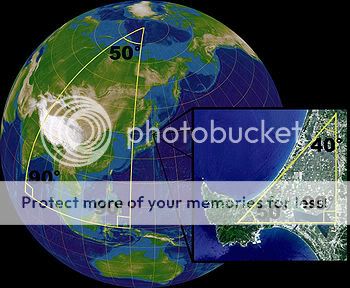BillSL, When you say he didn't necessarily go the cardinal directions, then the guy also didn't necessarily go in straight lines, which is why I said it invalidated the premise. A person can walk in a circle with a 30 mile circumference in alot of different places.
Oh no. Even if he did walk in a circle, he would HAVE to be within a 10 miles radius of the MN. Which is all water.
If he walked 10 miles S, 10 miles W and 10 miles N (and, as the OP, he arrived at the campsite) while using a compass, it would be exactly the same thing as if he was using original cardinal directions, but the "North Pole" would actually be somewhere in the sea in northern Canada.
For clarity sake, lets just assume a couple of things here. The south, east, and north directions are astronomic. Magnetic north is only used as a reference to astronomic and as GPS is becoming more widespread, the use for magnetic becomes less (except in the case of emergency equipment or power failures). (Those of us in the geodesy and cartography business cringe at the use of the reference "True North"...call it what it is....astronomic, magnetic, or grid.) The fact that the area is over water is inconsequential. Provided that the scenario occurs with the man walking over the terrain, one can deduct that the event occurred during the winter in that particular hemisphere.
Where (or who, for that matter) does it say he "walks"? He "goes"!
OP's question is, evidently, True North.
My "twisted" version is Magnetic North, for he is using a compass.
(Your conclusion/post is, therefore, inconsequential.)
BillSL-
I'm not sure of what you are asking other than the fact that the designation of whether it is astronomic or magnetic north was left out....
If he used a compass, he used magnetic north, as you have eloquently explained. Question is at OP's.
You are correct in that it can originate at the North Pole, but there are an infinite number of places on the Earth's surface where this can originate other than the North Pole, so why is it a Polar Bear?
Name 1 besides N pole (S pole is impossible, because you cannot head "south" if you are already at the southmost part of the earth. If you claim you have "walked without moving" (if you know what I mean), it would've violated the data at the OP (you would've never walked back into your campsite)).
The fact that the S pole has no bears is off the point.
(
.)since there are no bears at the south pole, then it has to be at the north pole.....
If instead you assume a great circle path starting in the given direction, then there is no solution. I cannot think of any other assumptions that would allow an infinite number of solutions as stated by evilleramsfan.
If the camper has started and ended in the same spot, and he has walked on 3 different directions, there are only 2 places on Earth. Just 1, actually, for the South Pole is negated for conflicting data.
OK, I suddenly recognized the other (infinite number of) solutions which occur when the westward leg results in a complete circle or multiple complete circles around the south pole. All such solutions have the initial starting point within approx 11.6 miles of the south pole.
Okay... Can someone please explain me how on EARTH (pwn semi-intended) will you get infinite possibilites, considering, as intended by the OP, that the camper has walked in 3 distinct directions and has arrived at the original spot?
Tone of this post is supposed to be light - it is hard to transmit a "peaceful" post in writing, normally.
As for the flag pole question. The wires cross at the same height regardless of the distance between the poles.
That's awesome to know! Thanks!
Last edited:




